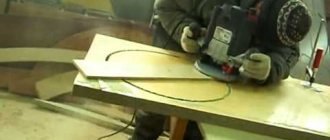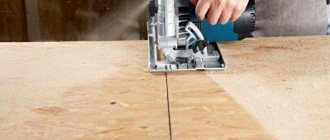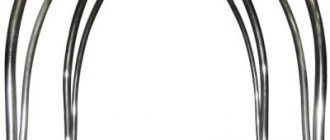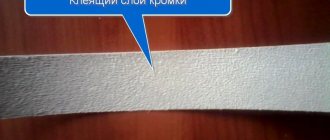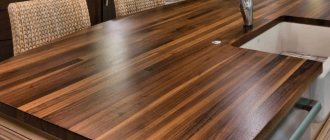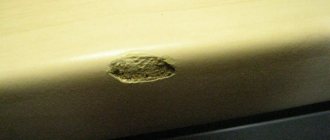Cutting round holes in plywood
Often, when repairing or installing various wooden products, it is necessary to drill a perfectly round hole.
In this article we will try to highlight all the ways in which such a hole can be cut. Options with the use of special tools, as well as without them, will be considered. How to cut plywood
A hacksaw with a very narrow blade, a jigsaw, a drill saw and a round file are among the hand tools that can be used to cut curves.
It is the narrow blade that provides maneuverability to the hacksaw, but for the same reason it is extremely difficult to operate. You must have a steady hand and an attentive eye to prevent deviations from the markings. However, do not try to work quickly. On the contrary, it is better to advance in small spurts. This will help you hold the saw handle more confidently and guide it exactly along the given line.
It is better to cut out small round or oval holes and “narrow” curves using special tools - a drill saw and a round file, which can also be used to clean out curves.
However, the most suitable tool for cutting rounded parts and holes is an electric hacksaw. Its advantage is not only that it saves energy and time. The included set of interchangeable blades with different teeth allows you to choose a blade for sawing almost any type of workpiece, be it wood, plywood or chipboard. In other words, an electric hacksaw can rightfully be called a universal tool.
Rules for working with a jigsaw
To understand how to properly saw a circle in wood, it is important to study the features. This carpentry tool helps to cut out ovals, wavy patterns, figures with uneven outlines, non-standard carved boxes, shelves with end-to-end patterns. To ensure that interaction with a jigsaw is organized and safe, it is important to adhere to the following rules:
In order for work with a jigsaw to proceed quickly and safely, do not forget to fix the product before work.
- To avoid inconvenience, special stands should be prepared during work. A slot is made up to the middle of the support, somewhat reminiscent of a lock hole.
- The stand is fixed with clamps or screws to the workbench.
- At the time of work, you need to sit down, position the file strictly vertically relative to the floor and perpendicular to the surface.
- The workpiece is placed in the middle of the stand, holding it with your left hand; you can saw the plywood with your right hand. The location of the cuts should be in the middle part of the support hole.
- The tool does not tolerate strong pressure: just a small touch and gradual movement up and down, and it will begin to work effectively.
Attributes:
- pencil;
- drill;
- drill;
- jigsaw
Plywood (and to a lesser extent other sheet materials such as chipboard or oriented strand board) has significant decorative potential. If you have a fairly simple tool and certain skills, you can cut almost anything out of plywood. But in order for the parts obtained as a result of such carving to look quite presentable, the master should have a few tricks in stock. We will talk about them in our article.
When starting to work with sheet materials, many craftsmen only have an idea of how to cut in a straight line. Therefore, the question of how to cut an even circle from plywood can confuse many. And indeed, a regular or circular saw cannot cope with the task. Figure cutting is most often done using the following tools:
- The simplest device used for sawing. With the help of a jigsaw, even the most delicate work can be done with your own hands, but for thick material or long cuts it is practically not suitable.
- Jigsaws. Here you can use two types of devices: a regular one, with a vertically positioned file;
- artistic, in which the role of the cutting element is performed by a steel blade.
Regular jigsaws will come in handy when working with thick ones. But if you are looking for a way to cut letters out of plywood or make other complex elements (for example, parts of a children's construction set), then it is best to use a model with a band saw.
Advice! Naturally, for each type of jigsaw there are several types of files and blades. The correct choice of cutting element is a necessary condition for high quality of the product.
- In addition to jigsaws, you can use a furniture router for curved cutting. Despite how difficult it is to operate, it is many times superior to most models of plywood saws in terms of the quality of the holes it makes. Using a router you can.
Also, do not forget about available devices, but we will talk about their use in the appropriate section.
Cutting from plywood has several nuances that the master needs to take into account:
- Firstly, you can only cut on dry material. High humidity leads to an increase in the resistance of plywood, therefore, with excessive force, either the veneer will begin to delaminate or the file will break.
- You need to change the saw or cutting blade immediately after the first signs that the teeth have become dull appear.
- If we are cutting from plywood using a jigsaw, then to obtain cleaner edges, the main cutting lines should be placed along the grain of the veneer. But with hand files it is easier to work across the grain: there will be slightly more chips, but there is less risk of the file getting pinched or moving away from the intended line.
Advice! When transferring designs for cutting from plywood onto the workpiece, try to place the template in such a way that the elements to be removed fall on areas with defects: knots, chips, stains, etc.
Conclusion
We hope that thanks to the information presented above, the question of how to cut a figure from plywood will not cause you any difficulties. Of course, figured carving on sheet material requires a certain skill and accuracy, but if you have a suitable tool, even a beginner should not encounter any particular difficulties. In the video presented in this article you will find additional information on this topic (also find out how to make a box from plywood with your own hands).
Source: fanera-info.ru
Inserting a sink according to a template
The sink is one of the most important elements of kitchen equipment. If you decide to cut your sink into your kitchen worktop yourself, the first thing you need to do is prepare an exact template.
First, transfer the outer outline of the shell onto a thick sheet of paper. Next, measure the width of its sides, which will rest on the tabletop. Usually this is 2-3 cm. Now step back from the outline drawn on the paper, inward by the width of the side and draw a parallel line. This will be the cutting line.
When applying markings, make sure that the position of the template itself on the plate is correct. Of course, if all the corners of the sink are symmetrical, then nothing bad will happen if, according to the markings, it appears to be in a mirror image. But if the sink has the shape of a trapezoid and the roundings at the front corners differ from the roundings at the back, then under no circumstances confuse the front and back parts.
Use a similar pattern to make templates and cut holes for wall lights or loudspeakers mounted on wood panels.
The line drawn around the sink is auxiliary. The second, drawn parallel closer to the center, is the sawing line.
Properties of metalworking tools
The jigsaw is intended for household and professional needs. Devices of the first type are characterized by low power and are designed for work in small volumes. The purpose of using special equipment is the professional orientation of the tool, its productivity and a long period of work.
Typically, household appliances have a standard set of functions:
- frequency of moves;
- method of fixing a sheet for cutting;
- pendulum type movement;
- turning the saw.
A jigsaw is used for finishing surfaces, cutting out uneven edges, internal holes, and making furniture. The processed material is securely fixed to the base. Marks are made on it in advance, then the holes are sawed. Rotational vibrations of the shaft are converted into translational movements.
The jigsaw has such positive qualities as:
- Cutting holes in any samples.
- A simple device allows you to quickly replace saws.
- Possibility to make round or rectangular cuts.
- Ease of use.
- Does not require special knowledge or skills.
- The presence of a significant number of saws with different step limits and tooth shapes makes it possible to carry out various types of work in the conditions of one device.
- Reliable fixation of the cut sample allows any distance from the edge of the product.
- The universal action device allows you to cut to any depth.
- During the work, the material is practically not damaged.
Disadvantages:
- The shortened movement of the blade ensures slower operation of the device.
- Possibility of injury.
- Possibility of cord failure.
- Checking the battery charge level.
The new products being released are equipped with improved functions: reducing the number of vibrations, improving productivity indicators, and equipping the device with convenient functions. Depending on the method of fixing the cutting part, saws are:
- with holes;
- with a cross-shaped element;
- with a smooth base.
In some ways, a jigsaw can replace a router, a hand saw, a circular saw, a chain saw, or a corner grinder. The tool is necessary in any household; it allows you to carry out wood carving.
The current supplied to the device from the network gives an impulse to the motor, setting it in motion. Together with the gearbox, it transmits the impulse to the gear, which secures the rod. The circular action of the shaft is modified into the movement of the working element of a reciprocating nature, moving up and down. The saws are fixed using screws or clamping mechanisms. Such fasteners help to change the canvas in a short time.
Electric hacksaw
If you need to cut a round-shaped part and saw a round hole in the workpiece, then an electric hacksaw is the most suitable tool. With its help, you will save effort and time, since such a saw has great advantages over a manual one. Thus, the blade of the electric hacksaw is narrower, which provides increased maneuverability. Further, it has replaceable blades with different teeth, which allows you to process workpieces of any type, that is, wood, plywood, chipboard (it is no coincidence that the tool is also called a jigsaw).
To cut a section inside the workpiece, a hole is first drilled for a hand saw. But if you have an electric hacksaw, then this is not necessary. The tool is brought to the workpiece with a slight tilt forward and turned on in this position. The saw will cut the hole itself. Just don’t put too much pressure on the body - this can lead to breakage of the saw blade.
Lead in a circle
This device, simple in design, makes cutting out round holes or arcs much easier. It is enough to mark the center of the circle on the workpiece, fasten the device along the mark and connect the rod coming from it with an electric hacksaw. The divisions on the rod help set the saw blade at the required distance from the center of the circle. As a result, without preliminary marking, you can cut a circle or saw an arc with a radius of 5 to 20 cm.
The device (more precisely, its “sole”) is attached to the surface of the workpiece with screws. They should be well tightened. If the fastening is not rigid and starts to wobble, then an even circle will not work.
Suitable for lefties too
Left-handers can also use the device, since the guide rod is attached to the movable unit both on the left and on the right. So cut at your own discretion - clockwise or counterclockwise.
Using such a device, you can cut a round hole with a diameter of 10 to 40 cm in the workpiece without preliminary marking.
Drill saw
Neither a hand saw nor an electric hacksaw will help if you need to cut a small hole in the workpiece - less than 10 cm in diameter. A jigsaw may also be useless if the workpiece is large. In this case, the most suitable tool is a drill saw. With its tip it bites into the wood like a drill and thus makes a “starting” hole for further cutting. Externally, the saw is similar to a round file with the difference that its shaft is surrounded by a spiral around the cutting edge.
Drill saws are available with interchangeable attachments of various diameters, designed for processing both soft and hard wood, as well as a variety of materials made from it.
The working body of a drill saw is a metal rod with a cutting tip, like a gimlet, and a cutting edge that goes around the rod in a spiral.
This is what the narrowest of hand saws looks like. Thanks to the fastening unit, the blades in the hacksaw can be changed depending on the nature of the material being processed.
Drill attachment
One of the most popular and convenient options for cutting a hole is a special attachment for a drill. It is made in the form of a crown comb and has a rounded shape. With this attachment, cutting holes occurs quickly, and they turn out quite smooth.
drill bit for holes
Nozzles come in different diameters, which allows you to cut a hole of the required diameter. If you have already prepared a hole, we can advise you to try your hand at options trading.
Drill
You can also cut a large hole using a drill. To do this, it is necessary to pre-mark the outline of the hole to be drilled. Next, use a small drill to drill through holes along the contour prepared in advance. Next, using a jigsaw or a very sharp knife, we cut off the holes, thereby connecting the holes. After which you can smooth the circle using sandpaper of various grain sizes.
Chisel
You can also cut the required hole using a chisel. It is enough to remove the wood layer by layer along the contour. This option is the least suitable for interior decoration. The hole must be smooth, which cannot be achieved by using improvised and unsuitable materials for the job. The best option would be to use a drill bit. The hole is even and has smooth edges.
Thus, to summarize, it becomes clear that you need to choose a tool for cutting a hole based on your goals. If you need a high-quality cut, then you cannot do without a special tool.
Shape cutting technologies
Jigsaw
As we noted above, a jigsaw will come in handy if we are looking for how to cut a word out of plywood or make other parts of complex shapes:
- We transfer pre-printed drawings or templates onto the workpiece using carbon paper.
Figured carving with a jigsaw: photo of the finished product
- If the structure has through sections, we make starting holes with a thin drill.
- Insert a file or jigsaw blade into the hole. Secure the free end of the file with a fastening screw or clamp.
- We make a cut along the intended line, pressing the workpiece to the workbench. The saw moves either automatically (for electric jigsaws) or manually.
After all the arc elements have been sawn, we remove unnecessary areas and process the finished part with a file or sandpaper.
Finished hole
Fraser
A furniture router is great for cutting out thick plywood. Of course, you can’t make a complex shape with it, but cutting an arc or circle is easy:
- We fix the standard ruler included in the router in the center of the circle using a self-tapping screw.
- If the length of the ruler is not enough, you can assemble a simple bracket from a metal profile or wooden planks.
- By rotating the cutter along a fixed radius, we select a groove along the circumference, resulting in an almost perfect hole.
Bracket for router: with it you can cut a disc of almost any diameter
Note! When calculating the diameter of the circle, you should take into account the dimensions of the working cutter. The instructions for the device will tell you the exact numbers.
In this way, you can cut not only circles, but also individual arcs - for example, in order to make grooves for furniture brackets.
Using improvised means
For shaped elements, it is advisable to have special devices, but any craftsman may need to make a round hole in a slab of laminated veneer. Below we will tell you how to cut a circle from plywood when you have nothing at hand. Well, almost nothing:
- To cut plywood, use a wooden strip with two nails.
- One nail is driven through the strip into the workpiece, exactly in the center of the hole being made.
- We drive the second nail into the bar so that the point protrudes on the wrong side by at least 5-10 mm. The distance from the first nail should be equal to the radius of the hole being made.
- Rotating the bar, use the tip to draw a groove on the plywood, deepening it with each turn.
- Instead of a stick, you can use a strong cord. The operating principle remains unchanged.
Diagram of "threading" using nails. The sharper the nail used, the faster the hole will be made. It should be noted that although the price of such a device is low, it is worth using it only when other methods are not available: the edges still turn out to be far from ideal.
A little about safety
To protect yourself from injury when working with a jigsaw, following these rules will help:
- Carefully study the operating instructions for the tool before using it, check its serviceability and the presence of all components;
- stop using unsuitable saw blades;
- manual jigsaws cannot be held by the frame; a special handle is provided for this;
- In electrical tools, the integrity of the insulation must be checked; its cutting part must be limited by special devices;
- When working, you must always use protective equipment - a shield, goggles, a respirator, gloves that will protect you from fine dust and shavings;
- at the workplace, be sure to provide good ventilation to remove dust and vapors of paint and varnish substances;
- carving is carried out slowly, keeping the distance between the hand and the blade;
- all electric heating devices should be located no closer than 5 m to the workplace;
- Upon completion of all work, the jigsaw is disconnected from the network.
Design and its features
Each jigsaw has a so-called support sole. It always rests on the part that needs to be sawed. Due to this, the accuracy of work is noticeably increased.
The soleplate can be easily rotated to make bevel cuts. Some manufacturers produce in which the main tool is fixed only at a certain angle.
The file acts as the main cutting tool. Tooth spacing, sharpening method, size, shape, materials - literally every model has its own. 75, 85 and 100 millimeters are the most suitable lengths if you need to cut materials of low density. The saw step size also becomes a fairly important parameter.
- Metal requires a pitch of 12 millimeters.
- For wooden products it is from 2.5 to 4.
Ways to minimize chipping
An additional reason for the formation of chips may be misalignment of the saw teeth. Therefore, the first thing you need to do is purchase a tool with a straight cut (often Bosh files). However, it should be taken into account that during prolonged use, such files overheat and may even bend during the cutting process. Therefore, it is necessary to take breaks from work to cool the cutting tool.
However, just replacing the saw blade is not enough and in order to cut laminated chipboard (laminate) with a jigsaw without chipping, you need to make minor modifications to the power tool. Namely, make sure that when the saw moves against the inclination of the tooth, the material does not pull out. For this purpose it is enough to make a persistent platform. You can come to this conclusion by trying to cut two sheets of chipboard at the same time. So there will be practically no chips on the lower element.
In order to make a stop pad for a jigsaw, it is enough to cut out a rectangle from any dense material (for example, laminate) with dimensions identical to the dimensions of the sole of the power tool.
Then, along the larger center line, you should make a notch and secure the resulting equipment to the sole of the jigsaw using insulating tape or double-sided tape. All modifications are ready and finishing work can be carried out in compliance with certain recommendations.
Why do you need a plywood circle?
Before you think about how to cut a circle in plywood with a jigsaw
, you need to clearly understand why it is needed. Subsequently, either the resulting round-shaped blank itself or a plywood sheet with a hole of the correct shape can be used.
Where a round piece of plywood can come in handy:
- for making various crafts and templates for them;
- used as a base for a wall clock;
- used for subsequent figure cutting or decoupage;
- act as the seat of a stool, the top of a kitchen or coffee table, etc.
- for creating various souvenirs, for example, boxes, etc.
You may also need to cut out the correct circle from plywood for subsequent use of a sheet with a hole:
- installing a mortise sink into the countertop;
- obtaining a ceiling with a cutout for round-shaped lighting fixtures (spotlights or one chandelier);
- for the production of furniture with decorative facades and other elements, etc.
Power tools or hand tools?
Tools and materials:
- drill;
- jigsaw;
- hand jigsaw;
- milling machine;
- nails;
- rope;
- chisel;
- hammer;
- stationery knife;
- sandpaper;
- compass.
When determining the diameter of the future circle, it is necessary to take into account the dimensions of the working cutter.
The most popular option among all is a jigsaw. This tool allows you to cut not only circles, but also any other geometric shapes. Its only disadvantage is the need to form additional grooves at turning points (corners), but this is not noticeable when creating a circle. It is very important to choose the right nail file, because... they come in 3 types: vomiting on the left, vomiting on the right, vomiting on both sides. After the canvas is selected, cut out a circle of any size.
An ordinary hand jigsaw. Before cutting a circle from plywood using this tool, you need to make sure that the workflow is accessible. The main difficulty is the limitation (usually up to 30 cm) due to the physical structure, i.e. It will not work in deep places. When starting work, not from the edge, but directly from the center, the nail file is threaded last.
Milling machine. A very convenient option, but it requires rigid adhesion to the surface, for which a self-tapping screw is screwed into the center of the circle. A circle can be made of any diameter, and very quickly. Sometimes there is not enough working handle, which is why you have to make all sorts of improvised brackets, which can be a channel, a profile, a block, a board or even a rope, but with a rigid hitch it is much more convenient. This tool makes a fairly wide hole, so before starting work you need to carefully measure the future structure.
It is necessary to select only sharp nails, and sand the edges of the resulting workpiece with coarse sandpaper.
Nails. A very popular method in cases where the work must be done “yesterday”, but the tools will not be available soon. It is worth noting right away that the work ends up being quite rough, so it is used as a last resort. All you need is a hammer, 2 nails and a rope. One nail is driven into the center of the hole, and the other is pulled on a rope to the required length (radius), after which a circle is drawn with a firm movement.
Chisel and stationery knife. Here everything is much simpler, because first you need to draw a circle with a compass (pencil), after which this circle is circled several times with a stationery knife under pressure. The peculiarity of the stroke is the movement not of a knife, but of a sheet of plywood, so as not to break the metal, and this action is repeated on 2 sides.
A jigsaw is a well-known hand-type tool designed for cutting patterns on various surfaces. In terms of its importance, it is as important as a drill or hammer drill.
A jigsaw is used for sawing various types of materials (wood, metal, etc.).
Currently reading: Fiolent jigsaw - review of the model range, main characteristics and owner reviews
They can make straight and curved openings in wood of any species and other non-natural materials, as well as precise cuts of geometric shapes with complex trajectories. The tips and recommendations listed here will help you figure out how to cut a circle with a jigsaw.
Jigsaw
When cutting holes or curves in small workpieces, sometimes you can’t do without a jigsaw. Replaceable blades with teeth of different shapes and locations allow you to work with wood of different densities. However, it should be taken into account that the depth of the cut is limited by the arc of the jigsaw, that is, the saw blade will not be able to move further than 30 cm from the edge of the workpiece.
Very thin, narrow saw blades can be easily damaged if the jigsaw is used incorrectly. The saw must be operated with careful, methodical movements. The main thing is to prevent the canvas from skewing. Otherwise, small and light workpieces will begin to move with the saw, which may ultimately lead to the blade bursting.
The thinnest jigsaw blade will “master” the narrowest curve, but only in small workpieces, since the advancement of the blade is limited by the arc of the jigsaw.
Tool characteristics
Jigsaws are divided into household and professional.
Using household tools with a power of 350-620 W, they perform a small amount of work on wood up to 70-80 mm thick, sheet steel up to 4 mm thick. A professional power tool is designed for a large volume of work, provides continuous operation for 8 hours, and productivity does not decrease. Household models have a smaller set of additional functions. Important operating functions are stroke frequency, power, method of fastening the saw blade, pendulum movement, equipped with a saw blade rotation device, regulation of the number of strokes to optimize work with different materials. Single-speed jigsaws without speed adjustment are used for sawing wood.
A jigsaw is often used when carrying out finishing work, for curvilinear cutting, creating internal holes, shaped parts in the manufacture of furniture, while the material being worked with needs to be fixed. To secure the material, you can use clamps; the cuts are first marked on the material, then the tool is turned on and sawing begins.
The principle of operation is to convert the rotational movement of the shaft into the translational movement of the working mechanism - the file. The file is mounted on a rod - a round plate, the quality of which determines the durability of the part. When choosing a power tool, you should pay attention to the round shape and thickened rods.
Scheme of cutting a circle with a jigsaw.
How to draw ellipses
An ellipse is a rather complex shape, but to draw it on paper, you only need two thumbtacks, a piece of string and a sharpened pencil.
Attach two buttons to the surface of the workpiece at some distance from each other. Take a piece of rope, tie both ends into a knot and hook the rope onto the button heads. Now, with a pencil, draw a line that the stretched rope allows you to describe. You can change the shape of the ellipse at your discretion.
The distance between the two focal points of the ellipse is indicated by buttons. If you guide a pencil within the boundaries assigned to it by a rope, then the outline of an ellipse will appear on the paper.
The ellipse shape can be larger or smaller, thicker or narrower, depending on the distance between the buttons and the length of the rope.
Professional secrets
It is necessary to check how firmly the canvas is fastened.
This mechanism may have its own characteristics depending on the manufacturer.
To work with any cutting tools, the fastening of the blade, its general position, is really important.
A useful device will be one that is responsible for removing sawdust. Its operating principle is very simple. There is a flow of air from the fan cooling the motor.
It is used to remove debris. The removal system makes the cut line more visible to the master's eye.
The drill can be easily changed when cutting holes using a technique called "pocketing". To do this, just tilt the jigsaw forward, then the rounded tips will rest on the surface being cut.
The blade should be positioned above the future cutting line with maximum accuracy. You need to lower the support saw horizontally, and then continue to practice.
For such work, marks are first made inside the material, and then, following them, the tool itself is drawn. If the shape is square or rectangular, the blade is pulled back slightly before the craftsman moves the tool to the next side. And so all four are processed.
The use of plunge cutting is permissible if it is impossible to create holes of the required dimensions. To do this, the jigsaw tilts forward until the file reaches the workpiece. Gradually during this process a through hole appears.
Wood grinding wheel for grinder
This is not exactly a wreath, but the base for the wreath is a frame on which you can attach various decorations. But the base itself is very beautiful - natural, made from natural materials, smelling of the forest! Making such a wreath is not at all difficult.
True, you need to spend almost a couple of hours on production. The main feature of the technology for making this wreath is that it turns out to be very SMOOTH - round, without branches sticking out in different directions. This is how to make such an even wreath that will be discussed in my MK. For work you will need: birch branches - preferably not dry, but flexible, which have only recently fallen from the tree; they can be collected under any tall and not young birch tree - it is better to collect long and thin branches, it is more convenient to weave a wreath with them - the approximate number of branches - see.
Conclusion
We hope that thanks to the information presented above, the question of how to cut a figure from plywood will not cause you any difficulties. Of course, figured carving on sheet material requires a certain skill and accuracy, but if you have a suitable tool, even a beginner should not encounter any particular difficulties. In the video presented in this article you will find additional information on this topic (also find out how to make a box from plywood with your own hands).
Source: fanera-info.ru
Final touches
Once you've finished your cut, sand down any tool marks. Sandpaper of different grits will help you with this. Use a variety of solvents to remove tape residue.
With these simple steps we have the round hole we need.
Instead of a compass
A school compass can also be useful in a home workshop, but its range of action is small. What if you need to draw a circle of large diameter?
An easy way is to do this with string, a nail and a pencil. The nail is carefully driven into the workpiece, the rope is secured to it at one end, and a pin is secured to the other end. The length of the rope determines the radius of the circle being drawn. The only condition is that the rope must be taut along the entire path of the pencil. Then the distance from the center (nail) to the circle in all sections of the marking will be the same.
An equally simple, but more reliable way is to use a strip of cardboard or, even better, a wooden plank instead of a rope. Drill two holes in this bar (strip) - one, smaller, for a nail, the other, larger, for a pencil. The distance between their tips should correspond to the radius of the desired circle. All that remains is to install the nail in the right place and rotate the bar around its axis.
Two sharpened nails and a wooden strip or a strip of thick cardboard can replace a compass.
How to cut a circle?
Many people enjoy a peculiar hobby called origami and paper crafts. This is a difficult, but very entertaining business that can be compared to art. In order for the products to turn out worthy of admiration, considerable dexterity, skill and talent will be required. Almost everyone can master the technique, but coming up with something new out of paper is a much more difficult task. As they say, test yourself first in a simple task. For example, cut out an even circle from paper. To complete a seemingly simple task, you can use a variety of methods.
Cutting out a circle using a compass
A circle is a perfectly even figure, the distance from the center of which to all its edges is the same. This distance is called the radius of the circle. If the question is how to cut a circle out of paper, you can use an excellent office tool - a compass.
This device, invented by mankind, looks like two pieces of wood or iron connected to each other. At one end of such a segment there is a pencil, and at the other there is a sharp end. Using this tool, you can easily draw a circle of any diameter. I think you know how to cut a circle out of paper with scissors. This simple method is suitable for making one piece.
If you want to cut out a lot of round blanks, take a compass and use it to draw an even circle on paper or cardboard. After this, attach the blank to paper or cardboard and cut out the circles with scissors or a stationery knife. This way you can very quickly cut the required number of round pieces for yourself.
Feather drill
Typically, a feather drill is positioned as a cheap and quite high-quality tool that can be used to drill a hole in chipboard or wood. The length of the shank allows you to go deep into a considerable distance; the choice of diameters up to 70 mm should also please you. However, in our experiment we will also try to make a blind (non-through) hole. So, let's go.
Already at the very beginning of the work, an interesting feature was discovered: on the packaging it was indicated that the drill is intended for drilling 34 mm holes; on the drill itself there is a mark of 32 mm. I had to take a caliper and measure.
The drill actually turned out to be 32 mm, and the indicated figure of 34 mm on the packaging remained a mystery to us for literally the next fifteen minutes. The drill tip allows you to install the tool exactly in the right place, although in our case the drilling did not require it. From the very beginning of work, the pen drill began to bite into the material with enthusiasm (not without our pressure on the drill, of course). After a few seconds, the drill was stopped to make sure that it was possible to make blind holes using a feather drill.
Theoretically, this is possible, but for this you need to have a fairly thick workpiece. Since the pen drill has a long tip, in our case, with a recess of only 6 mm, a small hole of about 2-3 mm appeared in the center on the reverse side.
Drilling a hole in the chipboard yielded the following results (see photo):
Feather Drill Entry Hole
back side
the edges seemed smooth, the inner surface of the hole wall was smooth, and with the stated drill diameter of 32 mm, the hole had a diameter of 31.9 mm. Such results deserve a rating of 5 points out of 5, although this is the first tool and perhaps one of the remaining ones can be even better. In the meantime, we believe that drilling holes in wood, chipboard and other similar materials is quite feasible for a pen drill with good results.
Templates
Shot glasses, cups, plates, pots or baking dishes - in any household there are many round-shaped objects that can be used to mark a circle. If you are making something and decide to give your product a rounded shape, then first look to see if there is a suitable template among the household utensils. To be sure, select a few items and take them to the workshop. There you can immediately try them on the workpiece and determine what is most suitable. With some practice, you will be able to make rounded lines from several round objects with different radii. Arcs of a circle can be drawn sequentially, or bridges-transitions can be made between individual arcs.
Preliminary drawing
Before attempting to trace a curve on a piece of paper, design it on a large piece of paper or piece of corrugated cardboard. Only after the result is satisfactory in all respects can you cut out a template from paper and make markings on it on the workpiece.
You can draw circles and fragments of a circle using a cup or plate by simply tracing them with a pencil.
Drilling blind holes in chipboard for hinges
Cup drills are used to drill blind holes. Chipboard is no exception. It is worth paying special attention to thin chipboards with a thickness of 16 mm. To cut a hole for a hinge with a diameter of 35 mm and a depth of 8-10 mm, the drill has an unacceptable depth. The drill bit will go right through the slabs and create an unwanted hole in the door face. To overcome this unpleasant situation, we do the following.
We start drilling with a 35 mm drill and make a hole of small depth. We obtain the remaining depth with a cup drill of a smaller diameter, moving it along the surface of our hole. Not much work, actually, because... The hinge cup is not strictly round in shape.
By the way, during operation the scattering of “fragments” is quite decent. To limit the range and reduce the time for subsequent cleaning, you can use a simple technique. A protective casing is made from a cake or pizza lid (it’s the latter in the photo below) (sounds pretentious). During operation, all sawdust is inside and nearby.
We remove the cardboard and sawdust all nearby. All that remains is to remove it with a brush/vacuum cleaner in one pass.
Maria , Access date: 2015-02-18 18:10:07
Please tell me what to do if the drill “leads”? The hole is ellipsoidal. Material - beech (everything is better on chipboard). The drill has a side blade. I’m already thinking about buying a machine for a drill or looking for someone to make it to order (((
Roman , Access date: 2011-08-01 19:14:59
It’s been a long time since I read somewhere this technique for drilling for hinges. Take two Forstner drills. One of them has the central spine completely cut off. Start drilling with a normal drill, finish with a sawed one - and the hole will be perfectly blind.
boris-yarovoj , Access date: 2011-03-24 17:51:23
About the letters A, B, C on the strikers. This is how they used to designate more accurately (I'm afraid to confuse the order of the letters) overhead, semi-overlay and inset hinges - Chinese manufacturers. It’s as if it was made especially for Chinese storekeepers (and for ours too). But the furniture maker doesn’t need to get hung up on this - look at what the loop actually is along the bend of its “neck” - i.e. what you hold in your hands and what you use, but these letters seem to be a thing of the past.
boris-yarovoj , Access date: 2011-03-24 17:42:37
There is no need to use two “Fostner drills” of different diameters. I choose one hole - 35 mm. It’s just that when you buy such a drill specifically for hinge cups - in chipboard 16mm - then you need to blunt the centering tip of the drill by the amount you need, so that it is just a little in front of the lateral incisors. In principle, you don’t even need to sharpen it after that - you just need to punch each future hole a little. Of course, you will need to develop the habit of holding the drill as perpendicular to the surface as possible. Before each drilling on a plane, I make a mark with a thick awl. This is also useful for drilling soot with an ordinary 8mm drill - a plane - for a confirmat (euro screw). More about the Fostner drill (you can’t put a stop on it): we develop a 6th feeling in ourselves - “first, we drill under the loop not all the way to the bitter end,” blow out the chips, try on the loop and, if there is a lack of depth, drill through with little effort (or better yet, again try on a hinge if you have doubts about your 6th sense). And probably it’s not even worth mentioning that there should be a flat surface of the workbench under the part, otherwise you can tear everything out without a drill, but simply with effort.
How to cut a circle from wood using a hand router
Piggy banks are now more of a decorative element than objects used for their intended purpose. And yet, many continue to use them as a means of storing small items. By dropping just coins of a couple of rubles into them, after a while you can find a pleasant amount inside for small and sometimes large expenses.
A stylishly designed tree trunk circle can become a real garden decoration! There are several design options for this area. For example, you can arrange a flower garden there, sod it with cereals, green manure, or fill the space with decorative mulch. Each method has its own characteristics and aims to improve the soil structure, retain moisture, provide protection from weeds and some pests, and fit harmoniously into the overall style of the landscape.
The trunk circle is an area around the tree trunk, which is equivalent to the projection of the crown. Until the age of five, a tree is considered young, so it is not advisable to cover the area around the trunk with anything, so as not to interfere with the development of roots. During this period, the soil around the trees must be watered, loosened, fertilized, and ensure that it remains moisture- and breathable.
The transformation is based on a circle. The circle represents the nature of power. And it can be put into action by writing a formula in a circle.
How to make a wooden garden path with your own hands, photos and videos
There are many possibilities for organizing garden paths. Many of these methods are very simple, and these ideas can be implemented on your own, without hiring professionals and even spending a very modest amount on materials.
The second most popular material for garden paths after stone is wood in all its shapes and colors. Wood is inferior to stone in terms of reliability, but it creates a feeling of warmth and does not require serious expenditure - both monetary and time.
Even in a garden decorated in a modern style, a wooden garden path looks very impressive. We have found wonderful instructions for you on how to make a garden path from wood cuts with your own hands.
You will need:
- several tree trunks of different diameters
- saw
- varnish for waterproofing wood and protecting against mechanical damage
Tire as an effective way to avoid wood destruction during bending
Since the main problem is fiber breakage on the outer radius side, it is this surface of the workpiece that needs to be stabilized somehow. One of the most common methods is to use an overhead splint. The tire is a steel strip with a thickness of half a millimeter to two millimeters, which covers the beam or board along the outer radius and bends on the template along with the wood. The elastic strip absorbs part of the energy when stretched and at the same time redistributes the destructive load along the length of the workpiece. Thanks to this approach, coupled with humidification and heating, the permissible bending radius is reduced significantly.
In parallel with the use of steel bars in bending devices and machines, mechanical compaction of wood is achieved. This is done using a pressing roller, which presses on the workpiece along the outer bending radius. In addition, the template form in such a device is often equipped with 3 mm teeth (in increments of about 0.5 cm), oriented towards the movement of the workpiece.
The purpose of the jagged surface of the template is to prevent the workpiece from slipping, to prevent mutual displacement of fibers in the wooden massif, and also to create a small depressed corrugation in the concave radius of the part (the fibers are pressed inside the massif, therefore, problems with folds are solved).
Pressing with a tire allows you to bend bars and boards made of coniferous and soft deciduous wood with a minimum percentage of defects. Please note that parts made of relatively hard wood when bent with pressing become approximately ten to twelve percent thinner, and pine and spruce blanks become 20-30% thinner. But the positive aspects of this method include a significant increase in the strength characteristics of the finished product, as well as a significant reduction in the requirements for the presence of flaws and defects in wood blanks.
Round corners of furniture
You can even get injured by hitting a sharp corner of the table. Therefore, we recommend cutting corners where possible. For homemade furniture, they need to be rounded from the very beginning.
Cutting circles and curved lines is no more difficult than making an absolutely straight cut on a workpiece, but under one condition: you have the right tool in your hands and you are good at it.
It may happen that the holes that you drilled to insert a narrow blade with a hand or electric hacksaw will end up in useful areas. To avoid such mistakes, you should mark all missing parts of the workpiece with shading.
Currently reading: Buy DeWalt jigsaws inexpensively in the Shuriki online store, price, reviews, photos, with delivery in Moscow.
You can make a circle on a workpiece not only with a compass. Any object of a similar shape is suitable for this purpose. This could be a pan, plate, cup or bowl. However, when starting work related to the repair of furniture or some piece of furniture, calculate in advance the need for parts with rounded contours or with round holes. It may be enough to make only minor changes to the design.
